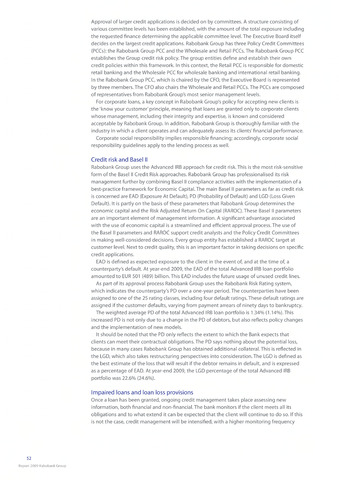Approval of larger credit applications is decided on by committees. A structure consisting of
various committee levels has been established, with the amount of the total exposure including
the requested finance determining the applicable committee level. The Executive Board itself
decides on the largest credit applications. Rabobank Group has three Policy Credit Committees
(PCCs): the Rabobank Group PCC and the Wholesale and Retail PCCs. The Rabobank Group PCC
establishes the Group credit risk policy. The group entities define and establish their own
credit policies within this framework. In this context, the Retail PCC is responsible for domestic
retail banking and the Wholesale PCC for wholesale banking and international retail banking.
In the Rabobank Group PCC, which is chaired by the CFO, the Executive Board is represented
by three members. The CFO also chairs the Wholesale and Retail PCCs. The PCCs are composed
of representatives from Rabobank Group's most senior management levels.
For corporate loans, a key concept in Rabobank Group's policy for accepting new clients is
the 'know your customer' principle, meaning that loans are granted only to corporate clients
whose management, including their integrity and expertise, is known and considered
acceptable by Rabobank Group. In addition, Rabobank Group is thoroughly familiar with the
industry in which a client operates and can adequately assess its clients'financial performance.
Corporate social responsibility implies responsible financing; accordingly, corporate social
responsibility guidelines apply to the lending process as well.
Credit risk and Basel II
Rabobank Group uses the Advanced IRB approach for credit risk. This is the most risk-sensitive
form of the Basel II Credit Risk approaches. Rabobank Group has professionalised its risk
management further by combining Basel II compliance activities with the implementation of a
best-practice framework for Economic Capital. The main Basel II parameters as far as credit risk
is concerned are EAD (Exposure At Default), PD (Probability of Default) and LGD (Loss Given
Default). It is partly on the basis of these parameters that Rabobank Group determines the
economic capital and the Risk Adjusted Return On Capital (RAROC).These Basel II parameters
are an important element of management information. A significant advantage associated
with the use of economic capital is a streamlined and efficient approval process. The use of
the Basel II parameters and RAROC support credit analysts and the Policy Credit Committees
in making well-considered decisions. Every group entity has established a RAROC target at
customer level. Next to credit quality, this is an important factor in taking decisions on specific
credit applications.
EAD is defined as expected exposure to the client in the event of, and at the time of, a
counterparty's default. At year-end 2009, the EAD of the total Advanced IRB loan portfolio
amounted to EUR 501 (489) billion. This EAD includes the future usage of unused credit lines.
As part of its approval process Rabobank Group uses the Rabobank Risk Rating system,
which indicates the counterparty's PD over a one-year period. The counterparties have been
assigned to one of the 25 rating classes, including four default ratings. These default ratings are
assigned if the customer defaults, varying from payment arrears of ninety days to bankruptcy.
The weighted average PD of the total Advanced IRB loan portfolio is 1.34% (1.14%). This
increased PD is not only due to a change in the PD of debtors, but also reflects policy changes
and the implementation of new models.
It should be noted that the PD only reflects the extent to which the Bank expects that
clients can meet their contractual obligations. The PD says nothing about the potential loss,
because in many cases Rabobank Group has obtained additional collateral. This is reflected in
the LGD, which also takes restructuring perspectives into consideration.The LGD is defined as
the best estimate of the loss that will result if the debtor remains in default, and is expressed
as a percentage of EAD. At year-end 2009, the LGD percentage of the total Advanced IRB
portfolio was 22.6% (24.6%).
Impaired loans and loan loss provisions
Once a loan has been granted, ongoing credit management takes place assessing new
information, both financial and non-financial. The bank monitors if the client meets all its
obligations and to what extend it can be expected that the client will continue to do so. If this
is not the case, credit management will be intensified, with a higher monitoring frequency
52
Report 2009 Rabobank Group

